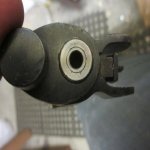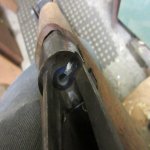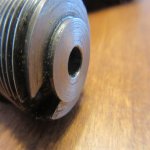You are using an out of date browser. It may not display this or other websites correctly.
You should upgrade or use an alternative browser.
You should upgrade or use an alternative browser.
SMLE no1mk3 parts sources?
- Thread starter cheasemonkey
- Start date
Removing a SMLE barrel is usually straightforward. Certainly easier than a No. 4. You'll need a receiver wrench and a barrel vise.
It's straight forward but those No1 receiver bend and deform very easily if you try to jack leg a receiver wrench and it has a sloppy fit.
Some of them appear to have been "glued" into place as well.
I took one off a few months ago that had a shim between the barrel shoulder and the receiver face.
Another thing about rebarreling a SMLE is that graduated bolt heads - like a No. 4 - weren't used. Boltheads were fitted.
So, when a barrel is replaced, indexing is important. You want the sights on top. And, you want the headspace to be within range.
So, when a barrel is replaced, indexing is important. You want the sights on top. And, you want the headspace to be within range.
A few of my parts put together. Everything I found locally. LSA 1918. View attachment 694397
That looks nice.
I suppose shims would work if the barrel turned in too far.
Headspacing a new barrel with used boltheads is going to be a bit of a crapshoot. The bolthead has to index properly on the bolt body, and also produce correct headspace. Having a sack of boltheads would help.
Headspacing a new barrel with used boltheads is going to be a bit of a crapshoot. The bolthead has to index properly on the bolt body, and also produce correct headspace. Having a sack of boltheads would help.
So you need to have a variety of bolt head sizes to try and no go and go gauges for that right? and shims for the sight indexing if needed?
Bolt heads, not sizes.
As per tiraq's posts above, SMLE are not like No4's where there are different bolt head numbers.
You'd have to have a lot of them and hope one had the manufacturing tolerance that matched what your barrel was set at.
So what's the proper procedure for rebarrel? what part needs to be fitted(machined?)
Now you're asking for someone to write a book for you.
Bolt heads, not sizes.
As per tiraq's posts above, SMLE are not like No4's where there are different bolt head numbers.
You'd have to have a lot of them and hope one had the manufacturing tolerance that matched what your barrel was set at.
Paul T, it's not just bolt head numbers that come into question with No1 bolt heads. they need to be "fitted" to the bolt so that they not only index properly but have correct headspace. This can be a real issue with No1 rifles of all variants.
The armorers and fitters that assembled these rifles originally had bins of different number bolt heads, some proprietary to the variant.
They were trained to stone the bolt head shoulders so that they would index properly for the bolt head with appropriate length to have give a proper headspace situation as well as keeping the bolt moving easily within the action rails/guides.
Those bolt heads are "hard" you don't just file/machine them to fit. Proper stones for the job are necessary and can be difficult to source.
Not dissing your post as it's mostly correct.
So what's the proper procedure for rebarrel? what part needs to be fitted(machined?)
-remove the old barrel. Proper tools needed.
-clean the threads, both receiver and new barrel. Inspect the receiver and barrel. Cross your fingers, and screw in the new barrel. If the stars are aligned, the barrel might pull up hand tight about 15-20 degrees from the sights being top dead center.
-if the barrel turns in, close to or past index, you might be able to upset the shoulder so that the barrel will pull up tight when torqued in. Or a shim could be fitted, or the barrel shoulder machined back and a breeching washer installed.
-if the barrel is too far from index, the barrel can be machined back to allow the barrel to pull up to index when torqued in.
-the barrel needs to be seated firmly. Spec for a No. 4 was 120 ft.-lbs. You don't need that much, but the barrel does need to be firmly turned to index. You don't want it wobbling or coming loose.
-OK, the barrel is installed. Once again, cross your fingers and try the bolt. Ideally, the bolt will close easily on a GO gauge, and either not close, or makes contact on the NO GO. Maybe you will get lucky. If not, you are going to have to start playing with boltheads.
You will need a receiver wrench and barrel vise. These are not cheap if you buy commercial ones. They can also be made. But don't try some jack leg improvised setup - too much risk of damage.
It is not rocket science, but it has to be done properly.
Ok, so not impossible but one of those things that can vary from easy as pie if you get lucky to major pain in the ass, as I suspected. Will report back once I've gathered everything. Is there a healthy supply of bolt heads out there to be had? or should I be snatching up every one I see in preparation?
tiriag gave you a very succinct explantion in layman's words.
He's given you the basics in a much shorter version than I would have.
The thing is, do you understand what he's telling you???
This isn't rocket science, but you need the proper tools, as well as the proper mindset to do this job.
Barrels with mounted sights are more difficult to index. Then of course, there is the extractor slot to worry about, but that should be good if the barrel is indexed properly.
Setting back the shoulder has its own issues. If you have to set it back to far and your chamber is already on the small side of spec, you may have to recut the chamber and reface the tenon as well.
If you haven't done one a No1 before, you may want to find a hand/eyes on mentor.
You likely have the appropriate skill set but these rifles have their own issues and you need to know what to look for.
Tiriaq is knowledgeable, with a lot of experience as well as intuition gained from that experience, which allows him to have a good undertanding of the relationship between the components and why they work or don't work.
Maybe you will get lucky, maybe not.
He's given you the basics in a much shorter version than I would have.
The thing is, do you understand what he's telling you???
This isn't rocket science, but you need the proper tools, as well as the proper mindset to do this job.
Barrels with mounted sights are more difficult to index. Then of course, there is the extractor slot to worry about, but that should be good if the barrel is indexed properly.
Setting back the shoulder has its own issues. If you have to set it back to far and your chamber is already on the small side of spec, you may have to recut the chamber and reface the tenon as well.
If you haven't done one a No1 before, you may want to find a hand/eyes on mentor.
You likely have the appropriate skill set but these rifles have their own issues and you need to know what to look for.
Tiriaq is knowledgeable, with a lot of experience as well as intuition gained from that experience, which allows him to have a good undertanding of the relationship between the components and why they work or don't work.
Maybe you will get lucky, maybe not.
















































































